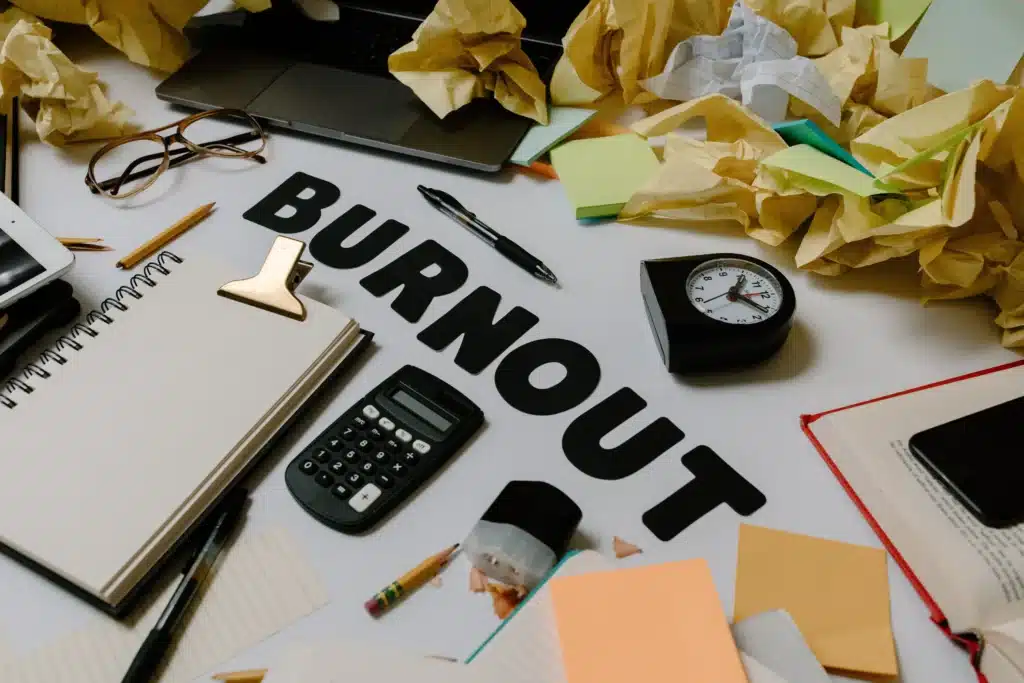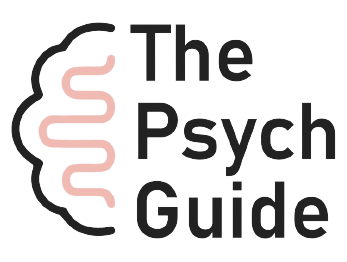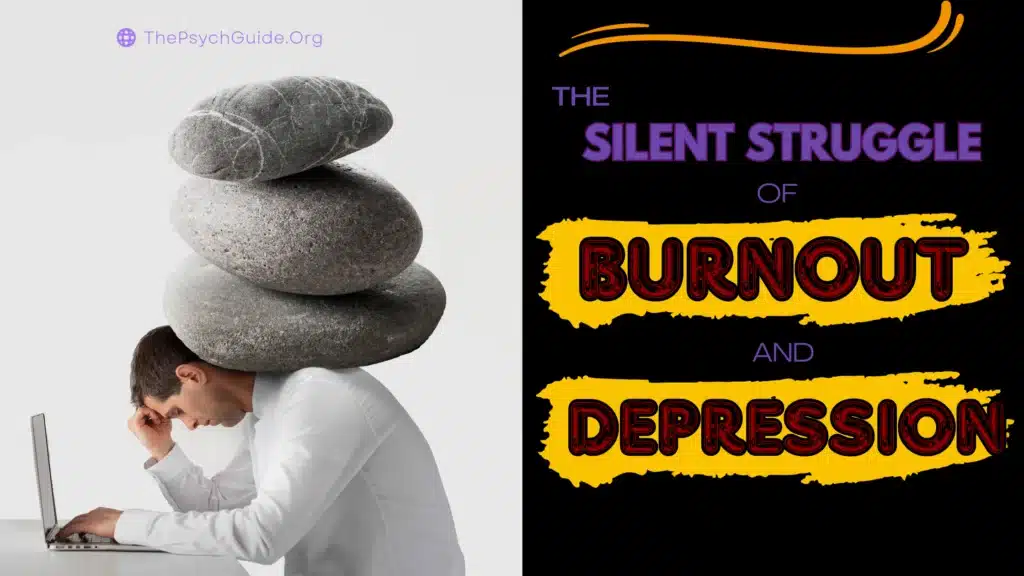Are you constantly feeling worn out, even after a good night’s sleep? Has your excitement for things you once loved faded, and everyday tasks seem like huge challenges? This is when you might be struggling with burnout and depression symptoms.
Burnout usually occurs when the demands of life or work become too much for you to handle; it drains your energy both physically and mentally. Depression, on the other hand, may overpower your emotions and thoughts. These symptoms can sometimes overlap and make it difficult to pinpoint what you’re really going through. That’s why it’s important to explore this connection and gain insights into how burnout depression symptoms can affect your life. By understanding the signs, you can start your journey toward healing and recovery.
In this blog post, we’re going to clarify the complexities surrounding burnout and depression symptoms, shedding light on their similar characteristics and distinctive features. Our mission is simple: to provide you with the knowledge and tools you need to recognize these symptoms in yourself or others and to help you reach a state of wellness. So stay with us till the end because we’ll offer some important practical tips and self-help books that may lead to a healthier, happier you.

Table of Contents
ToggleWhat does Burnout mean?
The terms stress and burnout are often used interchangeably by people. It is due to the fact that both of these are quite overlapping in meaning. Even in the literature, researchers consider burnout an aspect of stress. Some consider burnout a subcategory of stress. There is a fine line between stress and burnout. So are they different or not?
Well, we can understand it in this way. Suppose that at your job you are given some responsibilities that you need to fulfill, and with time you begin to feel like they are too much. You are expected to work overtime and even after work hours. At the same time, you are experiencing some issues in your personal life as well. Now you are starting to get anxious and feel like you need a break. You constantly feel the need to prove yourself. You are agitated, and your energy is declining by the day. What you are experiencing now is stress.
On their own, each individual factor does not seem much, but they are piling up on you. Then one day you feel like you can’t take it anymore, and you’ve collapsed altogether. Now you have lost all motivation to even try. You feel like all your efforts are useless and nothing is making a difference. At this point, you’ve burned out.
This is one distinction between stress and burnout. Stress is a response to a particular situation, while burnout is accumulated stress over time.
While stress is your response to some perceived threat, burnout is a state of total physical, emotional, and mental exhaustion. At this point, you’ve given up.
Existential theorists believe that burnout is a state where you feel like what you are doing is useless and your life has no meaning.
Stress, in some cases, can be taken positively as well. It all depends on how you look at the situation. See, stress is not a physical entity and does not exist outside of your mind. Some people see a “stressful” situation as a challenge and opportunity to grow. (Remember the time when you got bad grades and decided to try even harder?)
But there is no good kind of burnout. Burnout occurs when you have lost the ability to see the good in your situation.
Signs and Symptoms of Burnout?
Now, before moving on, we need to see how burnout manifests in people. What signs do you need to spot in yourself before declaring yourself (or others) burned out?
● Feeling physically and mentally exhausted.
● Having doubts about yourself and the effort you are putting in
● Feeling hopeless
● Feeling overwhelmed.
● Having no motivation to do things anymore
● Feeling like not getting out of bed in the morning and dreading starting the day.
● Pessimistic outlook on life.
All of these signs can show up in your physical health as well. This can include:
● Having frequent headaches or feeling a burden on your head
● Panic symptoms
● Feeling restless, agitated, or having no energy in your body
● Lack of sleep and appetite
We often think that burnout happens because of too much work and unbearable stress. It is hard for us to imagine that burnout can be caused by the opposite, i.e., a lack of work. Some experts, like Barry A. Farber believed that sometimes burnout can be due to a lack of purpose and meaning in life. This type of person he labeled as “under-challenged.”
So how common is burnout?
In the current climate of the world, burnout is becoming more common. There are numerous factors involved. Most of us have to deal with too much pressure; the burden of responsibilities is getting bigger and bigger, and social support is dwindling by the day.
- The American Psychological Association conducted a survey in 2021, through which they found out that in every workplace, 3 out of 5 workers reported mental and physical stress. 26% reported that they had no interest, energy, or motivation left; 32% were emotionally exhausted; and 44% showed physical signs of fatigue.
- It is interesting to note the generational experience of burnout. While 52% of individuals reported burnout symptoms in a study by Kristy Threlkeld, 2021, only 31% of them were baby boomers, and 59% were millennials and Gen Z.
- Burnout is not just a problem on an individual level; it costs organizations money. Many employees quit their jobs due to feeling extreme levels of stress. Research suggests that when job satisfaction is low and emotional exhaustion is high, the turnover rate is high as well.
- While burnout is most commonly associated with the workplace, it can also happen in other areas of life as well. For instance, the National College Health Assessment reports that 80% of college students feel overwhelmed and burned out. 40% of them reported feeling like it was too difficult for them to function.
- The burnout rate is not just high among college students; it is also high among teenagers. Teenagers experience burnout when they face emotional or physical challenges related to ongoing stress. 71% of high schoolers reported having experienced burnout at least once in their lives. But a more alarming thing is that 57.3% have experienced it more than once at such a young age. Jade Bluestone, 2022.
- Burnout is increasing at an alarming rate all over the world. In a study in which employees belonging to 15 countries were involved, McKinsey Health (2023) found that a quarter of those employees were having burnout symptoms.
What is Depression?
Just like burnout and stress, there is a fine line between burnout and depression symptoms.
To start off, one distinction is that burnout is not a diagnosable disorder, while depression is a diagnostic label. If you go to a therapist, they will not give you a diagnosis of burnout, but they can very likely declare you depressed. So having this in mind, burnout is a layman’s term, while depression is a clinically recognized diagnostic label for a set of specific problems.
Let’s have a deeper look at depression first.
Major depressive disorder, as the fifth version of the DSM calls it, manifests in the form of some specific symptoms:
● Feeling down most of the time (low mood)
● Loss of pleasure and interest in all activities that you previously liked or enjoyed
● Feeling jumpy, agitated, or drained
● You either sleep too little or sleep too much
● Being fatigued all the time. Not feeling refreshed even after rest
● Feeling guilt
● Being hopeless
● Weight gain or weight loss due to disturbance in appetite
● Feeling like life is not worth living and you should die (suicidal ideation)
These symptoms can last anywhere from 2 weeks to months or years
How common is depression?
Although depression can happen to anyone, some people are a lot more vulnerable than others. For instance, depression is more prevalent in women compared to men.
A statistic from the Institute of Health Metrics and Evaluation reveals that about 3.8% of the population has depression, among which 5% are adults (4% are men while 6% are women), and 5.7% are adults over 60. Close to 280 million people throughout the world have depression.
Now you may have noticed that there is a lot of overlap between symptoms of burnout and depression, and this is true. Now you will find some disagreement from researchers. Some say they are different, while others believe that burnout is one form of depression. Others believe that there is a lot more overlap between the two than previously suggested.
What is the difference between Burnout and Depression Symptoms?
Many experts are arguing and debating whether burnout and depression symptoms are clearly different or not. The overlap has been evident ever since the concept of burnout was introduced in the 1970s. Freudenberger (1974) acknowledged that when suffering from burnout, “an individual appears, behaves, and feels depressed”.
Let’s have a closer look
Burnout vs. Depression Symptoms
- Burnout is typically associated with work-related stress. We usually conceive of burnout as accumulated workplace or job-related stress. Depression, on the other hand, is a lot broader. It involves all aspects of life that affect performance overall.
- Exhaustion is usually a more prevalent symptom of burnout, while in depression, the major symptom is sadness and a low mood.
- Experts believe that one can usually pinpoint the cause of burnout, and while depression can have a cause, sometimes there isn’t any.
- They might be hard to distinguish, but when chronically low self-esteem, hopelessness, and suicidal ideation show up, it’s an indication that the problem is much bigger than burnout.
- Burnout is oftentimes a response to outside stress; on the other hand, depression can be biological, meaning it can have a genetic basis. As the study suggests, no biological basis for burnout has been found.
- According to research, there is a distinction between burnout and depressive symptoms in terms of their biological underpinnings. They include heart rate variability (HRV) and the levels of brain-derived neurotrophic factor (BDNF), including the stress hormone cortisol.
- While we know that there is a list of symptoms that are considered for depression, burnout is mainly conceptualized by scholars in terms of three dimensions; emotional exhaustion, feeling disconnected, and lack of efficacy. (Maslach et al., 2001)
- Oftentimes, burnout symptoms are managed by taking sufficient breaks. You might have noticed that when your problems are resolved and you take a few breaks, your stress level goes down, followed by a reduction in burnout symptoms. Clinical depression, on the other hand, requires clinical attention, and often there is a need for medication or psychotherapy.
Similarities between burnout and depression symptoms
Apart from these distinctions, burnout and depression symptoms have a lot in common. Many studies suggest that distinguishing them from each other is hard.
- Bianchi et al. (2013) found the Beck Depression Inventory-II (BDI-II) was unable to differentiate between depressed and burnout patients as they had very similar presentations.
- Gan et al. (2013) showed that participants scoring high on the burnout scale had a high probability of having MDD. A conclusion was made that burnout could be a phase through which MDD develops.
- Some of the common features of burnout and depression symptoms include feelings of exhaustion, sadness, and a sense of hopelessness. Additionally, both conditions can lead to changes in sleep patterns and a reduced interest in things you once enjoyed. Recognizing these similarities is important for understanding and addressing these challenges.
Can burnout and depression occur together?
Yes, burnout and depression symptoms can occur together. Although the symptoms can be very hard to distinguish from each other, it takes a professional to do that. The time period for depression is much longer than for burnout. Sometimes a person already has depression, and they happen to burn out as well due to overwhelming stress.
The symptoms of depression and burnout come together as burnout depression symptoms.
This can include:
- Feeling drained, overwhelmed, and emotionally depleted.
- Feeling tired all the time, even after getting enough sleep.
- Difficulty concentrating, making decisions, and solving problems.
- Feeling negative and cynical about work and disconnected from colleagues and clients
- Difficulty meeting deadlines and completing tasks to a high standard
- Feeling like there is no point in trying and that nothing will ever get better.
- Losing interest in activities that were once enjoyable and withdrawing from social engagements.
- Having thoughts about death or suicide, or engaging in self-harm.
Can Burnout cause Depression?
One query worthy of consideration here is: can burnout cause depression?
It is crucial to note that people with burnout don’t always have depression, and burnout does not necessarily lead to depression. But it does happen.
In answering “Can burnout lead to depression?” talking about personality is important.
A study published in the Journal of Social Psychology suggests that individuals with high neuroticism are more prone to burnout and develop depression as a result.
Similarly, individuals with an external locus of control are more likely to develop burnout and depression symptoms. (Gray-Stanley, J. A. et. al., 2016)
Research has demonstrated that anxiety and depression can result from ongoing stress and burnout. Relationship problems at work and in your personal life can also result from burnout. That’s why being able to identify when you are experiencing burnout in its early stages will help you take action before it worsens or leads to depression.
What are the Causes of Burnout Depression Symptoms?
There are many reasons why one can suffer from both burnout and depression symptoms. Some of them include:
- Work-related stress, such as heavy workloads, long hours, or job demands that are emotionally and mentally taxing, can contribute to both burnout and depressive symptoms.
- Lack of control over one’s situation is a very big contributor to burnout and depression symptoms.
- High expectations from oneself and your surroundings can lead to burnout and depressive symptoms.
- Lack of social support is a huge factor that can cause many issues.
- Inadequate work-life balance can also lead to burnout and depression.
- Genetic predisposition: A family history of depression can increase the risk.
- Traumatic experiences: Past trauma or loss can contribute to both conditions.
- Personality factors: Certain personality traits, like high neuroticism, low self-esteem, and pessimism, can play a role.
- Substance abuse: Alcohol or drug abuse can contribute to depression and burnout.
- Brain chemistry: Imbalances in brain chemicals, such as serotonin, dopamine, and norepinephrine, can contribute to burnout depression symptoms.
- Medical conditions: Some medical conditions, such as thyroid problems, cancer, and heart disease, can increase the risk of burnout and depression symptoms.
What is the impact of Burnout Depression on your life?
Burnout and depression symptoms can take a toll on your life if left unchecked. It disturbs our
- Work performance
- Emotional and psychological well-being
- Deterioration of physical health is a well-known consequence of burnout and depression.
- Relationships are greatly affected by burnout depression.
- Cognitive function can decline as a result, impairing one’s capacity to make judgments and leading to difficulties with memory, decision-making, and concentration.
- Social isolation can be the result if the problem is left unaddressed for too long.
- In severe cases, depression can lead to thoughts of self-harm or suicide, which is a critical and life-threatening consequence.
- If left unaddressed, burnout can lead to a self-perpetuating cycle where the individual becomes increasingly overwhelmed and disengaged from work and life in general.
How can we avoid Burnout and Depression Symptoms?
Just like for any other problem, prevention is better than cure. There are some tips that will be helpful for avoiding this issue in the first place.
- Learn to prioritize your problems. It will be especially helpful in the workplace
- Learn to say no and set boundaries. Remember that you don’t have to solve everyone else’s issue. It will significantly reduce your stress.
- Communication is the key to success. Learn and use it.
- Take regular breaks and rest. Remember that balance is vital everywhere.
- Check in with yourself. Ask yourself how you are feeling.
- Prioritize self care
- Try to foster healthy relationships. Don’t isolate yourself, and try to reach out to people.
- Make realistic and clear goals.
- Don’t be afraid to seek professional help if you feel like you need it.
Various forms of psychotherapy are found to be immensely effective for depression and burnout. The most notable of them are
- CBT
- Behavior therapy
- Mindfulness-based therapy
Medications like antidepressants or anxiolytic drugs can be very helpful in severe cases.
Conclusion
Ups and downs are a part of our lives, and we all have to go through confusion, stress, and anxiety in many phases of our lives. In some ways, they are vital to our existence because, without a little push, we’ll never move forward. Problems arise when we are unable to cope with these challenging demands. Among them are burnout and depression symptoms that often overlap, making it a greater challenge.
There are a variety of reasons for burnout and depression symptoms. One of them is stress piling up for a long time and our perception that we can do nothing to overcome it. It is important to keep in mind that, while it does not always happen, burnout frequently results in depression, which is a far more serious issue. If they are left untreated for a long time, it can have long-term negative consequences for your well-being.
Being able to recognize the signs is important not only for yourself, but this way you’ll be able to help your loved ones as well. One way to ensure this is by encouraging open conversation regarding mental health issues. Remember that each and every person you see around you is going through some struggles, so don’t be afraid to seek help and be helpful.

Self-help Books
It can be difficult to overcome life’s obstacles at times, but the right self-help books can provide insightful advice and practical tips to enhance your general well-being and mental health. The following books are worth reading:
● The Mindful Way through Depression is a self-help guide written by four expert authors. Mindfulness is a simple yet powerful technique for overcoming depression, which you can learn from this book.
● Lost Connections written by Johann Hari, an award-winning journalist, is a book that will help those who are unable to figure out the cause of their problems.
● Do Nothing by Celeste Headlee is an excellent book to overcome problematic thoughts and burnout and improve your life in general.
● Burnout: A Guide to Identifying Burnout and Pathways to Recovery is a very effective self-help guide for working through burnout
● Burnout is a boom specifically for women in workplaces, the issues they experience, and how they can overcome them.

